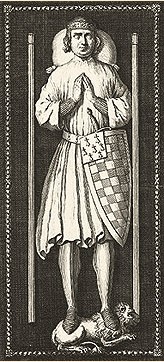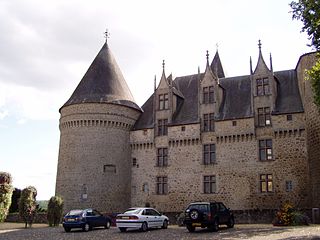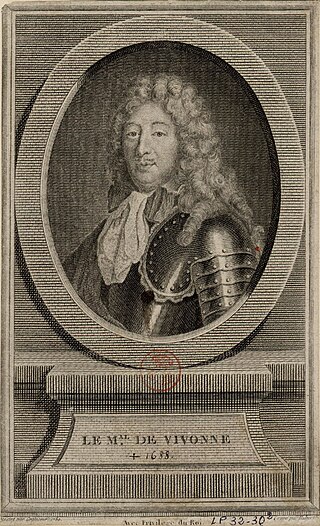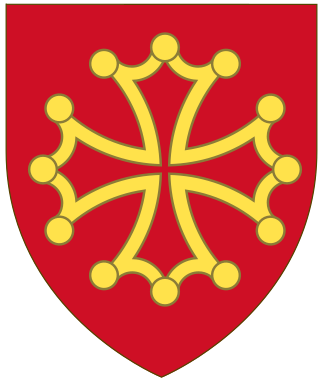This article needs additional citations for verification .(October 2020) |

Foucher de Limoges was the founder of the House of Limoges-Rochechouart, and the first Viscount of Limoges.
This article needs additional citations for verification .(October 2020) |

Foucher de Limoges was the founder of the House of Limoges-Rochechouart, and the first Viscount of Limoges.
The second son of Raymond I, Count of Toulouse, and of Berteys, daughter of Rémi. The viscounts of Limoges and of Rochechouart are thus descended from the Counts of Rouergue and probably from the Count of Autun and from Théodoric, who founded the Autun dynasty c. 730.
Foucher was a supporter of Charles the Bald and was rewarded for his services in the king's wars by being granted the Viscountcy of Limoges, which extended into Limousin and Berry. Foucher was crowned as viscount in 876 in Limoges and started minting his own coinage. The promulgation of the Capitulary of Quierzy the following year simultaneously freed the lords up from royal authority and made their titles and charges hereditary, thus giving birth to the French feudal system. Like other lords, the viscount of Limoges became an autonomous territory, administered by viscount Foucher. On his death, in 886, his son Hildebert became lord of Limoges, and then Hildebert's son Hildegaire, then Hildebert's grandson Géraud, establishing in a lasting way the dynasty of viscounts in their fiefdom of Limoges. [1]

A marquess, Dutch: markies, is a nobleman of high hereditary rank in various European peerages and in those of some of their former colonies. The German language equivalent is Markgraf (margrave). A woman with the rank of a marquess or the wife of a marquess is a marchioness or marquise. These titles are also used to translate equivalent Asian styles, as in Imperial China and Imperial Japan.

A viscount or viscountess is a title used in certain European countries for a noble of varying status. The status and any domain held by a viscount is a viscountcy.

Haute-Vienne is a département in the Nouvelle-Aquitaine region in southwest-central France. Named after the Vienne River, it is one of the twelve départements that together constitute Nouvelle-Aquitaine. The prefecture and largest city in the department is Limoges, the other towns in the department each having fewer than twenty thousand inhabitants. Haute-Vienne had a population of 372,359 in 2019.

Arthur II, of the House of Dreux, was Duke of Brittany from 1305 to his death. He was the first son of John II and Beatrice, daughter of Henry III of England and Eleanor of Provence.

Rochechouart is a commune in the Haute-Vienne department, region of Nouvelle-Aquitaine, west central France. It is a subprefecture of the department.

The House of Burgundy was a cadet branch of the Capetian dynasty, descending from Robert I, Duke of Burgundy, a younger son of King Robert II of France. The House ruled the Duchy of Burgundy from 1032 to 1361 and achieved the recognized title of King of Portugal.

Payzac is a commune in the Dordogne department in Nouvelle-Aquitaine in southwestern France.
Hugh VIII the Old of Lusignan or was the Seigneur de Lusignan, Couhé, and Château-Larcher on his father's death in 1151. He went on crusade, was captured at battle of Harim, and died in captivity.
William of Septimania was the son of Bernard and Dhuoda. He was the count of Toulouse from 844 and count of Barcelona from 848.

Château de Rochechouart is a thirteenth-century French castle, located at the top of the confluence of the Grêne and Vayres rivers in the commune of Rochechouart within the département of Haute-Vienne.
Raymond I was the Count of Limoges, Rouergue and Quercy, and Toulouse and Albi. He was the younger son of Fulcoald of Rouergue and Senegund, niece of William of Gellone through his sister Alda.
Bernard II, known as the Calf, was the count of Toulouse, Rouergue, Limoges, Nîmes, Carcassonne, Razès, and Albi. He was the son of Raymond I and Bertha. The dates of his reign are disputed: either 865–877 or 864–872.
Hugo José Jorge O'Neill was the head of the Clanaboy O'Neill dynasty, whose family has been in Portugal since the 18th century.

Beaulieu-sur-Dordogne is a commune in the Corrèze department in the Nouvelle-Aquitaine region, central France. Beaulieu is a medieval city, originally dominated by its great abbey of St Pierre, of which only the abbey church remains. On 1 January 2019, the former commune Brivezac was merged into Beaulieu-sur-Dordogne.

The House of Rochechouart is the oldest noble family in France. This powerful dynasty of the Carolingian era dates back to Foucher, supporter of Charles the Bald, who became viscount (vicomte) of Limoges in 876. His descendants—Limoges, Rochechouart, Mortemart and Brosse—ruled over the area for several centuries, providing many different French regimes with politicians, soldiers, functionaries and other notable figures. The family is named after the town of Rochechouart.

Alain I of Albret (1440–1522), called "The Great", was a powerful French aristocrat. He was 16th Lord of Albret, Viscount of Tartas, the 2nd Count of Graves and the Count of Castres. He was the son of Catherine de Rohan and Jean I of Albret. He was the grandson and heir of Charles II of Albret and became head of the House of Albret in 1471.
The House of Montoire, started with Nihard, Lord of Montoire. Later, through the marriages of Plaisante de Montoire and Helvise Doubleau, the possessions of Mondoubleau and Fréteval Langeais were added. The manor of Mondoubleau and, following the marriage of Pierre II de Montoire and Agnès de Vendôme, the county of Vendôme became part of the House of Montoire.

Louis Victor de Rochechouart, 2nd Duke of Mortemart and Duke of Vivonne was a French military officer and nobleman who was a member of the ancient House of Rochechouart. His father, Gabriel de Rochechouart de Mortemart, was a childhood friend of Louis XIII. His older sister was Gabrielle de Rochechouart de Mortemart, a celebrated beauty of the era; another sister was Madame de Montespan, the mistress of Louis XIV. He was made a Marshal of France.

The House of Toulouse, sometimes called House of Saint-Gilles or Raimondines, is the name of the dynasty that ruled the County of Toulouse.
Geoffrey III (Geoffroy III) (died 1145), Viscount of Châteaudun, son of Hugh IV, Viscount of Châteaudun, and Agnes, Comtesse de Fréteval, daughter of Foucher, Seigneur de Fréteval, and Hildeburge Goët. Geoffrey was also Seigneur of Mondoubleau by virtue of his marriage. This resulted in a significant increase in the holdings of the family of Châteaudun.